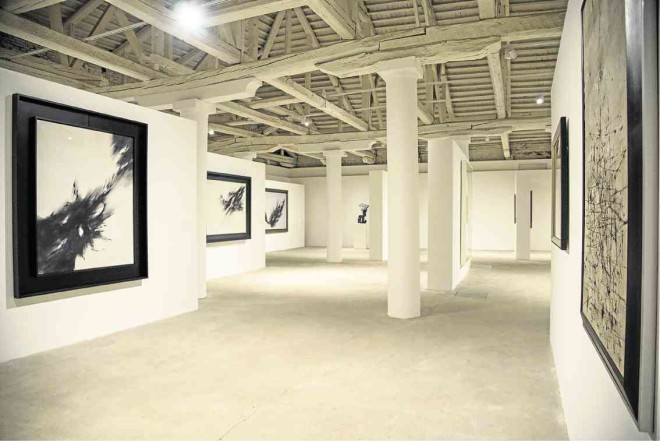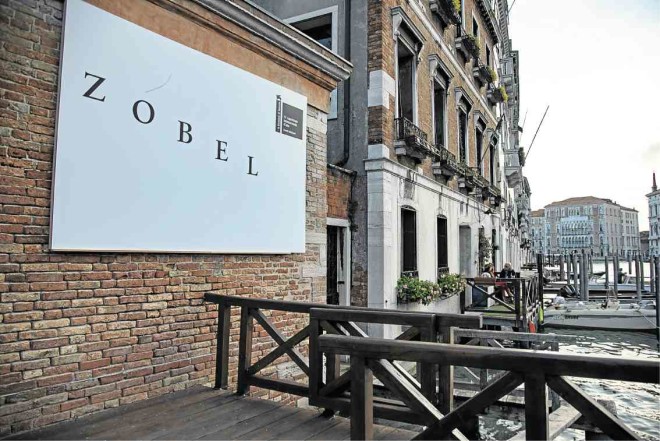
Fernando Zóbel has returned to Biennale Arte 2017 in Venice, Italy, after over five decades of his debut there in 1962.
The Venice art powwow, the biggest and oldest of its kind in the world, opened formally on May 13. The Zóbel show had opened for preview days before.
Zóbel’s “Contrapuntos” is mounted at Fondaco Marcello, San Marco 3415, Calle del Traghetto o Ca’ Garzoni, by Ayala Museum, whose establishment in the late 1960s had been envisioned by Zóbel.
“Contrapuntos” has been selected by La Biennale di Venezia to be among the 22 collateral events of the festival. This is the first time a Philippine museum is participating in Venice.
Curated by Ditas Samson of Ayala Museum and Madrid-based intermedia artist Guillermo Paneque, the collateral event is inspired by Biennale Arte 2017’s theme “Viva Arte Viva,” which celebrates artists, including those who have passed away.
Ayala Museum says its exhibit seeks to introduce Fernando Zóbel (1924-1984) to the new generation of art lovers.
Zóbel had been exhibited in the 1962 Venice Biennale among 20 artists of the Spanish Pavilion.
“Contrapuntos” focuses on Zóbel’s art-making between 1957 and 1962 when he developed his signature style synthesizing Asian and Western painting techniques, as exhibited in his “Saetas” and “Serie Negra” paintings.

The young Zóbel had been enrolled in the premedicine course at University of Santo Tomas until World War II stopped his studies.
Nursing a spinal problem later, he decided to pursue a career in the arts and, after the war, went to Harvard, where he took up philosophy and letters. After finishing magna cum laude, he returned to Manila and joined the family business, painting early in the morning and working in the office most of the day.
Travels, influences
Starting as a representational artist, Zóbel painted colorful renditions of Philippine Catholic motifs, drawing from his fascination with religious art as well as his travels around the country with historian Benito Legarda Jr. documenting Philippine churches. The research and travels resulted in pioneering studies on Philippine church art and architecture.
Along the way, Zóbel exhibited at the Philippine Art Gallery; explained modern art to a befuddled audience obviously still ensconced in conservative art; and patronized the works of pioneering Filipino modernists—Vicente Manansala, HR Ocampo and Arturo Luz.
A big factor in Zóbel’s development as an artist was his stint as a visiting artist at the Rhode Island School of Design in 1954. He saw the works of Abstract Expressionist Mark Rothko and realized a single element, such as color, could communicate a range of emotions as effectively as much as an elaborate figurative work.
Later, his travels around Europe exposed him to the works of Spanish abstract painters. The exposure to a varied set of influences made him shift from representation to pure abstraction with his “Saeta” series.
Drawing from his premedicine studies, Zóbel used a hypodermic syringe and experimented with the use of the line—exploring its forks and bifurcations and perhaps, adopting Rothko’s use of colors, playing with density and evocation.
On exhibit in Venice is Zóbel’s “Serie Negra,” black-and-white paintings that are stark and meditative. In fact the artist drew from his readings of Zen Buddhism, an instance of his philosophical approach to art.
Seminal work
In 1960, Zóbel moved to Spain.
In 1966, he founded Museo del Arte Abstracto Español in Cuenca, Spain’s first museum of abstract art.
In 1984, Zóbel died of a heart attack in Rome. He was posthumously given the Gold Medal by the city government of Cuenca; Medal of Honor by the Universidad Internacional Menendez y Pelayo Santander; and Presidential Medal of Merit by the Philippine Republic, the same award that would be later given to Juvenal Sansó, another Spaniard whose artistic fame is associated with the Philippines.
Zóbel’s seminal abstract series “Saeta,” also on show in Venice, underscores his evolution to pure nonobjectivism and minimalist colorism. The lines are searingly Oriental, extremely fine and calligraphic, prefiguring the purer, more spiritual “Serie Negra.”
In a way, Zóbel had gone back to the fond spirituality of his earlier works exalting Christian iconography, although decidedly shorn of Baroque elements.
“Saeta” means “arrow” or “dart” or even “pointer”: a fitting image for an artist whose work and philosophy set pointers—and counterpoints—for the charting and exploration of braver, newer and bolder artistic maps.
Visit biennalezobel.ayalamuseum.org.

